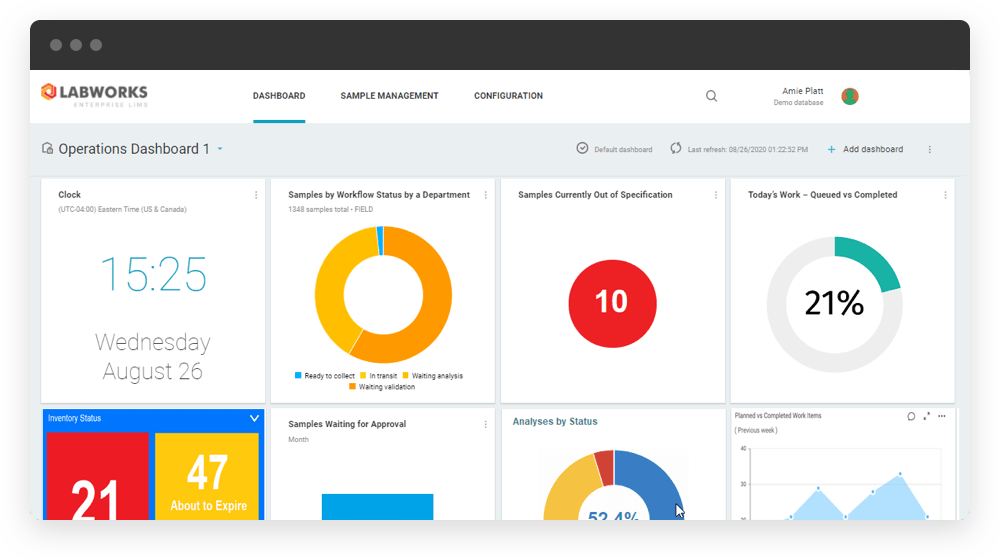LABWORKS is the most robust, flexible, and accessible LIMS data management software for your laboratory.
LIMS Implementation
The Labworks Difference

Implementing a new laboratory information management solution (LIMS) updates your data management system and adds efficiencies that result in cost savings and better lab performance.
Proper LIMS implementation eases the transition to a new system for your team. It also reduces the initial learning-curve time loss and overall implementation costs. Start reaping all the benefits of your lab’s new integrated management system as soon as possible. Discover everything you need to know about a LIMS implementation below.
New to LIMS? Here’s Why It’s Important
Every type of lab needs a way to manage its data. Without data management, labs would fail to perform their primary function. Credible lab analysis, experimentation, and research depend on well-collected and organized data. Your lab’s industry, purpose, size, and process will determine the specific features your data management solution will need. But, no matter how you break it down, laboratories across all industries need data management.
Biology Labs
Clinical Labs
Diagnostic Labs
Environmental Labs
National Labs
Manufacturing Labs
Medical Labs
Processing Labs
R&D Labs
Benefits of LIMS software
Labworks LIMS improve your lab’s workflow in various areas that all add up to a tremendous investment. Labworks clients tend to see a quick return on investment (ROI) after implementing new LIMS.
The following are just some of the ways LIMS can help your lab:
- Elevated morale
- Greater job satisfaction
- Improved data accuracy
- Improved data security
- Increased productivity
- Increased revenue
- Reduced costs
- Reduced employee attrition
Learn more about LIMS software and implementation from Labworks’ answers to common LIMS questions.
Common Challenges of LIMS Implementation (And How to Avoid Them)
While implementing a new LIMS can significantly benefit your lab, the implementation process can also present some challenges. Your implementation will also go smoother when you work with an experienced lab software provider, like Labworks. They can help you plan ahead to avoid these common challenges of LIMS implementation.
Choosing the Wrong LIMS
Choosing the wrong LIMS can be a disastrous and costly mistake. The wrong LIMS software can cause delays in implementation, create errors, and disrupt workflow.
Take the time to compare LIMS vendors and products. Don’t settle for a colleague’s word-of-mouth suggestion. Choose your data management system based on data.
Consider the following factors when choosing your LIMS software:
- Compatibility
Your new LIMS software and all of its functions and automations should integrate with your company’s existing computer systems to streamline implementations. - Configurability
Your LIMS should be tailored to your business. Each department that interacts with the LIMS needs the ability to configure its interfaces to suit the needs of its specific function. - Flexibility
LIMS software should standardize and integrate laboratory data procedures while remaining flexible enough to streamline workflow across all lab interfaces. It should also have the ability to incorporate new functions as your lab grows. - Functionality
Some LIMS come with standard features you can use right after installing. Others require installing additional tools for complete functionality. Know what you’re getting and ensure it will work for your needs. - Usability
A LIMS should simplify your data management system and make your laboratory’s workflow easier.


Overtaxed Software or Development
Software overloaded with niche functions may not perform well. It can lag or even crash. Your team will struggle to adopt using a sluggish system that slows them down or causes them to repeat work.
Don’t overload your LIMS implementation with too many requirements. Focus on the main objective for your system and get it implemented and working. If you choose the right provider, you can always add other functions later.
Underestimating System Requirements
Failing to understand your data management needs fully can lead to wasted money. You could end up investing in a LIMS system that doesn’t perform the tasks needed, slows down workflow, or creates more significant systemic problems. Don’t get stuck with LIMS software that either doesn’t work or people struggle to use.
Before you choose your LIMS software, analyze your lab’s needs carefully. Consider current needs and future needs. Getting a complete picture of your LIMS requirements ahead of time will help eliminate waste and create a better system for your lab. It’s also a step on the road to a successful LIMS integration.

7 Simple Steps to LIMS Implementation Success
1. Specify System Requirements
Identify everything required of your LIMS to make implementing it a success for your lab and your business. The requirements should include the functionality needed by the system’s primary users, any data analysis or reporting tools, and the total number of expected users. Be sure to seek input from your IT, reporting, data management, and business departments. Clarifying your lab’s needs beforehand will help you choose the right LIMS and the right LIMS vending partner.
2. Choose an Experienced LIMS Provider
A LIMS software implementer can provide a smooth, reliable transition to your new system. They can also help you set up automation in your LIMS and configure your lab’s records management system for scalability.
LIMS software providers have the experience to implement your new system quickly and address any issues that may arise. They’ll also take the time to configure your system to the way your lab works, including reports, naming conventions, abbreviations, and table layouts. When you enlist the help of an experienced LIMS implementer, you get people working on your LIMS full time without pulling your IT team off their regular duties.
Things to consider when choosing a LIMS provider
Look for LIMS software providers with good reviews and a solid reputation.
You can trust Labworks for all your LIMS software needs. Labworks easily configures your LIMS to your lab’s specific needs. Our latest software allows users to work off-network while still running a traditional desktop system. The web-based platform includes additional analytical tools and dashboard optimizations. Our experts will work closely with you and your team to ensure Labworks meets your immediate and long-term needs.
Labworks has provided LIMS for over 400 labs of various sizes and industries. Our team is dedicated to creating innovations that lead to customer success. We focus on people, process, and technology to create a holistic approach to our LIMS integration.
Learn more about how Labworks can help with your LIMS integration project.
3. Document and Communicate Objectives
Ensure your LIMS functions match your laboratory’s business objective, not just its data management needs. Clearly stating and documenting those objectives will help your LIMS provider configure the system to help meet those objectives. Share the written goals with your LIMS vendor.
Your new LIMS system may require updates to some of your lab practices. Those changes should compliment your business objectives, not undermine them. Your LIMS provider can align your practices and objectives through the software configuration and implementation.
4. Know your Data Types and Formats
Don’t forget that the main reason for implementing a LIMS is to collect and manage your data. Be sure you specify to your LIMS provider any data sets you need. Also, inform them of any data perimeter requirements. Data parameters can include formats, character restrictions, coding keys, or anything else that helps catalog data.
Understanding your data requirements will help your LIMS vendor configure your data management system to work with your databases and streamline your LIMS integration.
5. Understand Hardware Needs
Your new LIMS system may also include hardware along with the software. For example, if your lab is updating to a bar code scan-in system, you’ll need the scanners. In some cases, labs require upgrading some workstations or servers if they aren’t capable of handling current software.
Consider all of your hardware needs before beginning to implement your LIMS. You need to know which pieces of hardware are included with the system and which your lab needs to acquire. Discuss any potential hardware needs with your LIMS provider.
6. Secure your Data
Maintain security on your data throughout the LIMS implementation process. Many labs store personal data, including medical test results. Talk to your LIMS implementer about a plan to keep your data safe while they transfer it to the new system. Cloud-based storage systems can become compromised. Labs with highly-sensitive data may need additional security arrangements during the LIMS implementation’s initial data transfer.
7. Test the System with Use Cases
Implementing a laboratory information management system may start straightforwardly, but it can become more complicated. Test your LIMS implementation by using all the features with actual use cases.
Don’t rely entirely on projections or modeling. Punch in actual numbers from a real-life scenario. Running test cases will help you identify and troubleshoot problems with your new LIMS software before going live.
How to Implement a LIMS System
The implementation of your new LIMS can affect its usefulness and thus the success of the entire data management upgrade project. With proper planning and execution, you can successfully implement a LIMS system that meets expectations and doesn’t waste resources on unnecessary features. With the preparation done, now it’s time to execute.
The following steps will help you successfully implement your LIMS software.
Verify Your Software
If your lab requires software verification, your LIMS vendor can undergo the necessary steps to formally verify your LIMS.
Software verification can include the following:
- Preparing a specific software verification plan
- Documenting system requirements
- Testing that demonstrates the software meets each requirement
- Summarizing test cases in a final written report
Vendors and users usually meet verification requirements during development and testing of their LIMS. You can also get help from software developers or a third party to perform the software verification process. However, the LIMS developers who customize your specific system will usually know best how to get it verified quickly.


Integrate your LIMS software
Create a detailed plan for integrating your new LIMS into your current operating systems and switching over to using it. Work with your LIMS implementation expert to set a date for your lab and ensure everyone knows the plan and makes all necessary preparations.
Include the following items in your LIMS integration plan:
- Date and time of the software switch
- The new LIMS system user adoption date
- Software deployment assignment
- Notation of potential system blackouts expected during the switchover
- Lab data backup plan and documentation
- A final testing checklist for verification processes and security protocols
Prioritize LIMS training
A new LIMS system’s success is as much about the people using it as the software. If no one adopts the new system, the whole project could become a waste of money. Training staff and other end-users on the new interfaces and system integrations will be a crucial part of your LIMS implementation. This training is called user acceptance testing.
Experienced LIMS vendors, like Labworks, have experience training staff of various sizes to quickly get them up to speed on their new systems. Don’t rely too heavily on your own in-house training. Professional LIMS trainers will be more familiar with the software and can help identify the differences between user errors and actual bugs that need to be addressed in the coding. They also have experience training on similar LIMS systems.
Keep your staff doing their jobs, and let your LIMS vendor train your staff.


Identify additional use cases.
As you implement your LIMS and apply test cases to it, you may identify other uses for your LIMS that weren’t in the original plan. If these new use cases require changes to the software, your LIMS vendor can immediately begin working with you to configure a system update to accommodate the new functions you need.
Detailed feedback from initial testing will help identify use cases and enable your LIMS vendor address any kinks or bugs. They can then make the changes to keep your system running smoothly while still fulfilling the requirements of each new use case.
Labworks is the Proven LIMS Provider for 400 Labs and Counting
At Labworks, we understand that your data is the lifeblood of your lab. We have been pioneers in accurate and efficient lab data management since 1985. Our robust, simple-to-use data management solutions can give your lab a significant boost in efficiency and all of the financial and morale benefits that come with it.

A Holistic Approach
We proudly provide you with more than just software.
The right product.
While LABWORKS is easily configured to your specific needs, LABWORKS has also incorporated into its DNA many industry and lab best practices which will immediately improve your lab operations.
The right team.
Our industry-leading team of experts will work closely with you and your team to ensure LABWORKS is configured to meet your immediate and long-term needs.
The right approach and focus.
Product innovation and customer satisfaction are the foundation of our LABWORKS culture and drives our motto of “Do what it takes” to ensure customer success.



